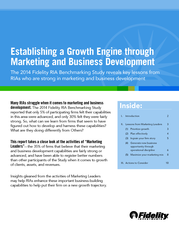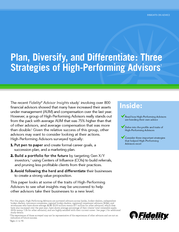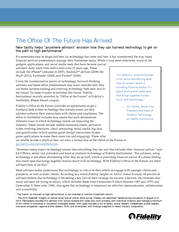Women on the Move in Bank Brokerage Article - Amanda Smith, SVP at National Financial
National Financial Services
Description
The younger generation wants to have ‘one hand on the
steering wheel’ when it comes to investment decisions.
Fidelity certainly feels that way, she
says, adding: The firm has built its
business on the backs of the baby
boom generation. “And a lot is
happening with them [boomers] now.”
They are retiring, liquidating their
businesses, selling their homes, and
they have lots of liquidity—2.5 times
the investable assets of their heirs—“so
we’re really focused on them.”
sign off on—investing decisions. This
is an investment generation that wants
to have ‘one hand on the steering
wheel.’
The fact that the bank channel has a
high percentage of female advisors
bodes well for engaging younger
investors because females, again,
tend to be more collaborative and are
Female investors place a high value on
establishing a personal relationship
with an advisor, no matter if the advisor
is male or female. “What they do care
about is good chemistry.”
Indeed, when Fidelity asked its survey
respondents which client segment
they were focusing on, the No.
1 target remained baby boomers. They are still the ones most likely to walk through a broker/dealer’s doors to open a new account. But the boomers’ impact is declining, and “we are about to hit an inflexion point,” says Smith. By 2017, there will be more Gen Xers walking through the doors than boomers, and by 2023, more Gen Yers than boomers. Banks should be thinking about that, asking themselves: “What is our sweet spot going forward?” ‘Validators’ Advisors in all channels will need to better engage with younger investors. The use of technology is important for this target group.
“They engage with technology in a different way.” They want to use online tools, for instance, so they can “visit” their money. They don’t want advisors making all their investment decisions for them, either. Rather, they are what Smith calls “validators.” They want to ‘validate’— less likely to make solo investment decisions. They are willing to let these younger investors ‘validate’ investment decisions. There are misconceptions about younger investors.
One common one is “that they don’t have any money,” notes Smith. Data show that Gen Xers are now entering their peak earning years, and Gen Yers are moving out of entry level jobs into career jobs, so both groups have more to invest now. They are also inheriting money. Accenture estimates that $30 trillion will be passed from boomers to Gen Xers and Gen Yers in coming years. Yet 90 percent of children who inherit money do not keep their parent’s advisor. That advisor has often not engaged with him/her, according to the Fidelity survey results.
Only 25 percent of advisors consider intergenerational issues to be part of their job. All in all, there is a “tremendous missed opportunity” here that banks may want to take advantage of, Smith suggests. Gen Xers and Yers shouldn’t be overlooked on the producer side, either. Indeed, “the success of the younger advisors” was one of the surprises of the survey, according to Smith. Younger advisors often have higher AUM than even boomer advisors.
One reason, as with women advisors, is that they are more likely to “team” with others, which often results in more efficient practices. Another explanation is that younger advisors are using technology in a different way, says Smith. Not only do they favor things like paperless options, they also use technology to communicate with clients—not just email, but increasingly through social media, which the industry has been slow to embrace (admittedly, there have been some compliance monitoring challenges to resolve). The industry is now embracing social media, however, and younger advisors are in the forefront of this trend. “Younger advisors aren’t chained to face-to-face meetings,” unlike some older advisors, adds Smith. When something big happens in the market, an older advisor may be on the phone all morning discussing developments with key clients.
A younger advisor might use a webinar or other means to respond to developments. In sum, women and Gen Xers and Yers represent an underutilized asset when it comes to staffing bank-brokerage programs. Footnote 1 “Seventy percent of widows end up leaving the family advisor within a year of a husband’s death,” see Kristan Wojnar and Chuck Meek, “Women’s Views of Wealth and the Planning Process: It’s Their Values That Matter, Not Just Their Value,” Advisor Perspectives, March 2011 Andrew Singer is editor-inchief of BISA Magazine. He can be reached at asinger@bisanet.org Reprinted with permission from BISA Magazine. BISA Magazine is an independent company, unaffiliated with Fidelity Investments. The statements and opinions expressed in this article are those of the author. Fidelity Investments cannot guarantee the accuracy or completeness of any statements or data.
Fidelity does not provide advice of any kind. This reprint is supplied by National Financial Services LLC. Member NYSE, SIPC. 200 Seaport Blvd, Boston, MA 02210 688352.1.0 Published in BISA Magazine, Quarter 1 2014.
Copyright 2014. All rights reserved. This file is for web posting and email distribution only; may not be used for commercial reprints. Provided by The Reprint Outsource, 717-394-7350 .
1 target remained baby boomers. They are still the ones most likely to walk through a broker/dealer’s doors to open a new account. But the boomers’ impact is declining, and “we are about to hit an inflexion point,” says Smith. By 2017, there will be more Gen Xers walking through the doors than boomers, and by 2023, more Gen Yers than boomers. Banks should be thinking about that, asking themselves: “What is our sweet spot going forward?” ‘Validators’ Advisors in all channels will need to better engage with younger investors. The use of technology is important for this target group.
“They engage with technology in a different way.” They want to use online tools, for instance, so they can “visit” their money. They don’t want advisors making all their investment decisions for them, either. Rather, they are what Smith calls “validators.” They want to ‘validate’— less likely to make solo investment decisions. They are willing to let these younger investors ‘validate’ investment decisions. There are misconceptions about younger investors.
One common one is “that they don’t have any money,” notes Smith. Data show that Gen Xers are now entering their peak earning years, and Gen Yers are moving out of entry level jobs into career jobs, so both groups have more to invest now. They are also inheriting money. Accenture estimates that $30 trillion will be passed from boomers to Gen Xers and Gen Yers in coming years. Yet 90 percent of children who inherit money do not keep their parent’s advisor. That advisor has often not engaged with him/her, according to the Fidelity survey results.
Only 25 percent of advisors consider intergenerational issues to be part of their job. All in all, there is a “tremendous missed opportunity” here that banks may want to take advantage of, Smith suggests. Gen Xers and Yers shouldn’t be overlooked on the producer side, either. Indeed, “the success of the younger advisors” was one of the surprises of the survey, according to Smith. Younger advisors often have higher AUM than even boomer advisors.
One reason, as with women advisors, is that they are more likely to “team” with others, which often results in more efficient practices. Another explanation is that younger advisors are using technology in a different way, says Smith. Not only do they favor things like paperless options, they also use technology to communicate with clients—not just email, but increasingly through social media, which the industry has been slow to embrace (admittedly, there have been some compliance monitoring challenges to resolve). The industry is now embracing social media, however, and younger advisors are in the forefront of this trend. “Younger advisors aren’t chained to face-to-face meetings,” unlike some older advisors, adds Smith. When something big happens in the market, an older advisor may be on the phone all morning discussing developments with key clients.
A younger advisor might use a webinar or other means to respond to developments. In sum, women and Gen Xers and Yers represent an underutilized asset when it comes to staffing bank-brokerage programs. Footnote 1 “Seventy percent of widows end up leaving the family advisor within a year of a husband’s death,” see Kristan Wojnar and Chuck Meek, “Women’s Views of Wealth and the Planning Process: It’s Their Values That Matter, Not Just Their Value,” Advisor Perspectives, March 2011 Andrew Singer is editor-inchief of BISA Magazine. He can be reached at asinger@bisanet.org Reprinted with permission from BISA Magazine. BISA Magazine is an independent company, unaffiliated with Fidelity Investments. The statements and opinions expressed in this article are those of the author. Fidelity Investments cannot guarantee the accuracy or completeness of any statements or data.
Fidelity does not provide advice of any kind. This reprint is supplied by National Financial Services LLC. Member NYSE, SIPC. 200 Seaport Blvd, Boston, MA 02210 688352.1.0 Published in BISA Magazine, Quarter 1 2014.
Copyright 2014. All rights reserved. This file is for web posting and email distribution only; may not be used for commercial reprints. Provided by The Reprint Outsource, 717-394-7350 .









